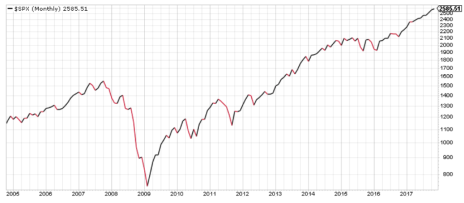The S&P 500 hit a new high on November 7, just a few points shy of 2,600. The Dow also tagged a new high that day, as did the Nasdaq, which came within four points of 6,800. I don’t want to overstate the case, but when large-cap stocks (the S&P), blue chip stocks (Dow) and tech stocks (Nasdaq) are all hitting new highs at the same time, investors (particularly value investors) have got to be asking what is going on?
And just to up the ante on that question, Japan’s Nikkei just rose to its highest level since 1992, the German DAX Index hit a record high and the MSCI Emerging Markets index finally got on top of its old all-time high from 2007.
The result of all this prosperity is that most investors—at least the ones who are paying attention—are nervous, fretful and finding it hard to go five minutes without checking their portfolios on their smartphones.
Why? Well, a quick look at a monthly chart of the S&P 500 will tell pretty much the entire story.
Yes, 2011 brought no progress and the index took a break during 2015, but otherwise, the story of the U.S. stock market since early 2009 has been bullish, bullish, bullish!
So, since everybody knows that bull markets can’t go on forever, when do the bears get their chance?
And, even more important, when will value investors catch a break?
Growth=Great, Value=Vexed
Value investors rely on a supply of undervalued stocks to put their strategy to work, and the supply of undervalued issues is as low as it has been in more than a decade.
While Morningstar figures tell us that the average equity fund holds 3.2% of assets in cash, many high-profile value funds now have between 20% and 40% of their assets in cash. Their hope is that the market will crash, presenting them with a great opportunity to put all that cash to work grabbing beaten-down stocks at bargain prices.
But right now, these cash-heavy value funds are trailing their benchmarks, which is not something value managers are used to. The value investing strategy is heavily data-driven, and involves holding stocks that are trading at a discount to their intrinsic worth. Value requires broad diversification to spread risk and value stocks can take a year or two to return to their “correct” price.
In an environment where an ocean of capital is actively pursuing stocks with good stories and numbers higher and higher up the mountain of price, all value investors can do is twiddle their thumbs. There’s not much to buy.
Growth investors don’t have it all their way, of course. Growth investors are notoriously optimistic, but even investors with the sunniest of dispositions know that The Great Bull Market of 2009–2017 will have to end sometime. And when that thought creeps into your head, each day can seem like just one day closer to the Great Correction of ????
My advice for dealing with this conundrum is simple. Get over it!
Value Investors Losing Money By Waiting
If you’re someone who has congratulated yourself for being a value investor and looked down your nose at deluded growth investors (maybe chanting to yourself the old efficient market hypothesis that “nobody can beat the market in the long run”), you need to look at the above chart for a long time.
Every day that you haven’t had some exposure to growth stocks is another day of opportunity risk that you’ll never get back.
If you’re afraid of the next correction, you should think about a strategy that will get you out of the market before it can take your profits away. That’s what Cabot’s growth investing strategies do, get you into the market when things are going well and get you out and into the safety of cash when markets go sour.
Don’t let your long-term suspicion of growth keep you out of the long-term bull market that is working so well for subscribers to Cabot Global Stocks Explorer (formerly Cabot Emerging Markets Investor) and Cabot Growth Investor. We’ll steer you right.





